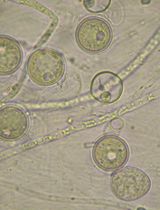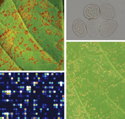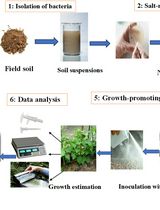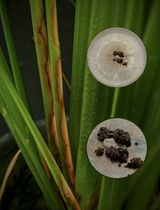- EN - English
- CN - 中文
Rapid Screening and Evaluation of Maize Seedling Resistance to Stalk Rot Caused by Fusarium spp.
玉米苗对镰刀菌所致茎腐病抗性的快速筛选与评价
发布: 2018年05月20日第8卷第10期 DOI: 10.21769/BioProtoc.2859 浏览次数: 8655
评审: Zhibing LaiAnonymous reviewer(s)

相关实验方案

微生物提取物对卵菌辣椒疫霉菌和猝倒病疫霉的体外筛选
Mónica Trigal Martínez [...] María Ángeles Vinuesa Navarro
2025年09月20日 1232 阅读
Abstract
Corn stalk rot caused by Fusarium spp., a genus of soil-borne fungal pathogens, has become a major concern of maize production. This disease normally causes significant reduction of maize yield and quality worldwide. The field assay for identifying stalk rot resistance using adult plants is largely relying on large population, yet time-consuming, labor costs, and often influenced by environmental conditions. Therefore, a rapid and reliable assay for investigating maize stalk rot caused by Fusarium spp. is required for screening the resistant lines and functional study of maize resistance to this pathogen. We have developed a seedling assay to rapidly screen the resistant lines using 12-day to 2-week-old seedlings. The entire assay can be completed within approximately 16-18 days post seed germination, with inexpensive labor cost and high repeatability. This simple, rapid and reliable assay can be widely used for identifying the maize resistance to stalk rot caused by Fusarium spp. and other similar fungal pathogens.
Keywords: Corn stalk rot (玉米茎腐病)Background
Maize is one of the most important staple food crops and energy plants worldwide. It has been becoming the No.1 crop species in China and worldwide regarding both yield and planting areas since 2012. However, corn stalk rot has become one of the most destructive diseases, which normally lead to significant yield loss and quality reduction of maize extensively (Oerke, 2006). The pathogens causing corn stalk rot mainly include the soil-borne fungal species, such as Fusarium graminearum, F. verticillioides, Colletotrichum graminicola, Pythium aphanidermatum, and Pectobacterium chrysanthemi. Infection of maize by F. graminearum (teleomorph Gibberella zeae Schw. Petch) normally causes Gibberella stalk rot with reddish-pink discoloration inside the stalk, and Gibberella ear rot with carcinogenic mycotoxins deoxynivalenol (DON) and zearalenone produced in mature corn kernels that are harmful to human and animals (Mesterhazy et al., 2012). Moreover, F. graminearum is also the major causal agent infecting other small grain cereal crops, such as wheat, leading to the well-known Fusarium head blight (FHB), which is one of the most serious diseases impacting wheat production in China and is endemic in many wheat-producing countries (Walter et al., 2010; Ma et al., 2017). F. verticillioides [=F. moniliforme J. Sheld.(sexual stage: G. moniliformis Wineland)], on the other hand, predominantly infect maize, resulting in Fusarium stalk rot and Fusarium ear rot, and producing Fumonisins, another type of mycotoxins in maize kernels (Presello et al., 2008). Thus, the increasing prevalence of mycotoxins produced by Fusarium spp., along with their direct impact on yield losses in many cereal-growing regions worldwide, has become one of the major concerns of much research.
In recent years, due to the rapid development and application of mechanization, the harvesting technology of corn grain by machines puts forward a high requirement of disease resistance to corn stalk rot. Currently, the field assay for identifying stalk rot resistance using adult plants is largely relying on large population, yet time-consuming, labor costs, and often influenced by environmental conditions. Therefore, a rapid, reliable and large-scale method for screening disease resistant lines and identifying the resistance to corn stalk rot is extremely in urgent, which can provide a great convenience for the researchers to rapidly excavate the elite genetic resources of maize. We have previously deployed a seedling assay to identify the resistance of maize lines to stalk rot caused by F. verticillioides (Gao et al., 2007). Here, we describe the detailed procedures of modified protocol of a seedling assay, which can be applied to evaluate the stalk rot not only caused by Fusarium spp., but also other fungal pathogens, such as C. graminicola.
Materials and Reagents
- 1.5 ml centrifuge tubes (Nanjing Qingke Biological Company)
- 50 ml centrifuge tubes (Nanjing Qingke Biological Company)
- Long pot (20 cm tall x 5 cm diameter), hand-made with PVC tubes with a holed bottom cover
- Parafilm (Bemis, catalog number: PM996 )
- Press-in Saran Wrap (GLADR, Pressin Seal, 21.6 m x 30 cm), a type of sealing saran wrap with stickiness that can be pressed on the surface to seal tightly the object
- Conical bottle (200 ml)
- Paper towel (230 x 225 mm, Yong Li Yu Investment Company Limited, May Flower, catalog number: A18250S )
- Cheese cloth (40S Warp x 40S Weft; 5 m x 1.2 m), made by combed cotton
- Soil (Nanjing Shoude Company, nutrient soil: vermiculite = 2:1)
- Syringe needle (Luer-Lok 20G, BD, catalog number: 309634 )
- Plastic square trays (Purchased from market) (100 cm length x 80 cm width x 10 cm height)
- Maize seeds (Inbred line: B73; select the similar size seeds with germinating rate > 90%)
- Fungal strains: Fusarium graminearum (isolate: F0609); F. verticillioides (isolate: 7600)
- Sterile ddH2O
- Glycerin
- PDA (Potato dextrose agar) (Qingdao Hope Bio-Technology, catalog number: HB0233 )
- Tween-20 (SunShine Bio, catalog number: T0014 )
- Mung Bean (Purchased from market)
- PDA media (see Recipes)
- Mung bean soup (see Recipes)
Equipment
- Pipettes (Eppendorf, Research Plus, catalog numbers: 3120000020 , 3120000046 , 3120000062 )
- Hemacytometer (0.100 mm, Hausser Scientific, catalog number: 3110 )
- Water bath (Changzhou Nuoji Instrument, catalog number: HHS-11-1 )
- Clean bench (AIRTECH, model: SW-CJ-1FD , catalog number: A16116317)
- Constant temperature incubator (Ningbo Jiangnan Instrument Factory, catalog number: DNP-9162 )
- Growth chamber (Ningbo Jiangnan Instrument Factory, model: RXM-508C-3 , catalog number: 17091559)
- Centrifuge (Eppendorf, model: 5424 , catalog number: 5424FL570190)
- Microscope (Olympus, catalog number: BX41 )
- Autoclave
Procedure
文章信息
版权信息
© 2018 The Authors; exclusive licensee Bio-protocol LLC.
如何引用
Sun, Y., Ruan, X., Ma, L., Wang, F. and Gao, X. (2018). Rapid Screening and Evaluation of Maize Seedling Resistance to Stalk Rot Caused by Fusarium spp.. Bio-protocol 8(10): e2859. DOI: 10.21769/BioProtoc.2859.
分类
植物科学 > 植物免疫 > 宿主-细菌相互作用
您对这篇实验方法有问题吗?
在此处发布您的问题,我们将邀请本文作者来回答。同时,我们会将您的问题发布到Bio-protocol Exchange,以便寻求社区成员的帮助。
Share
Bluesky
X
Copy link











